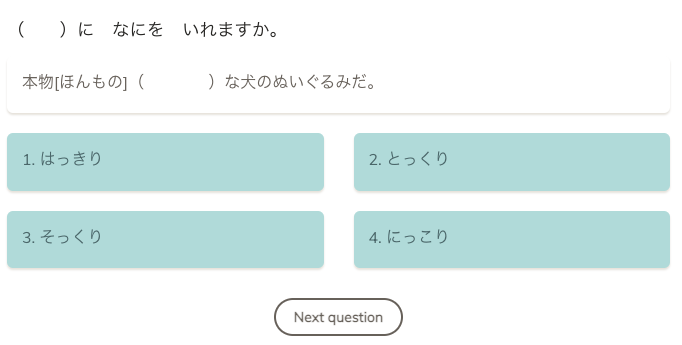We have already written an article “【Complete Ver.】Study Tips to Pass JLPT N3”, but don’t you want to know how to study each part of JLPT?
In this article, we will be writing about 言語知識(文字・語彙)/ letters and vocabulary.
Reading of Kanji + Correct Kanji
Kanji is one of the most difficult parts for Japanese learners, but at least you are not required to write it down on paper in the exam.
Then, how to memorize efficiently Kanji for JLPT?
We highly recommend you study Kanji every day not only looking at the application or textbook but also making some sentences with Kanji that you learn.
Active learning enables you to save time in the future because it is harder to forget what you have learnt with this study method.
Anki is definitely one of the best services to study Kanji.
It allows you to study with various decks created by learners and it shows not only the meanings but also the example sentences.
As I mentioned above, it is essential for you to input the usage of Kanji.
The image is from a self-learning Japanese learning platform that allows you to study for JLPT for FREE.
Don’t forget to learn Kanji with an example sentence!!

If you are interested in tips for JLPT N3, this article also can help you!
👇
Correct Word + Correct Usage
In this question of JLPT N3, you are required to know all of the meanings in order to choose the correct word. Fortunately, JLPT is a multiple-choice question and you have a 25% chance of choosing the correct answer without knowing the correct answer.
However, if you fail to choose the correct answer in a relatively easy question, you could lose a lot of points on the JLPT. The score of JLPT is decided with the score pattern of participants, which is very difficult to foresee before taking the exam. That is why you should score as higher as possible.
*if you know the theory used in JLPT, please check this video.
Therefore, to ensure that you can answer this type of question correctly, please follow the study tips below.
- Answer the question.
- Check the correct answer.
- Try to make a sentence using the grammar or word you learned.
- Check the meaning and usage of the other options so that you be familiar with them for the future.
【Example】

Correct answer: そっくり (=Exactly like, very similar to)
→私の友達の顔はお父さんそっくりだ。(My friend’s face is very similar to his father’s.)
The other options:
1)はっきり: Clearly
→先生の声は遠くでもはっきり聞こえる。(The teacher’s voice can be heard clearly even at a distance.)
2)とっくり: Sake bottle
→私は友達にきれいなとっくりをプレゼントした。(I gave my friend a beautiful sake bottle.)
3)にっこり: smile
→彼女は私ににっこりとほほ笑んだ。(She smiled at me.)
You can learn four things from a single problem.
To use your time effectively, always review it, even if you can only choose the correct answer.
Paraphrase
The tricky part is the paraphrase question.
You must first understand the meaning of the words and expressions in the question, and then know the meaning of the words and expressions in the choices.
So, how can you make sure you answer these questions correctly on the JLPT?
You can do this by combining the two study methods mentioned above.
First, please focus on studying vocabulary to increase your vocabulary. If you do not understand the meaning of a word or expression in a question, you will not be able to choose a correct answer.
You will also study grammar questions at the same time. In grammar questions, you can learn four things from a single problem.
Study the words to improve your vocabulary and the grammar questions to learn more about the different expressions.
Paraphrase questions require both vocabulary and grammatical knowledge, so it is advisable to be aware of this on a daily basis.
Time Allocation
Ideally, each grammar question should be solved within 30 seconds.
If you don’t know the answer to a grammar question, you should decide in advance what number you are going to choose so that you don’t waste time.
If you leave a question blank because you don’t know it, you are likely to make a marking error at some point.
Make sure you mark one of the four options, as one marking error can lead to all subsequent questions being wrong!
FREE Training for JLPT
If you want to pass JLPT, we are always with you. Our Japanese learning platform offers you various learning FREE materials (N5〜N1), such as Dashboard to manage your study time, Flashcard for Word, Mini test, Lecture, and Training of Vocabulary&Grammar, Reading and Listening.
© 2021 GLOBAL ASTRA Inc. All Rights Reserved.

We offer the Best Online Japanese Learning (All Free), and our goal is to facilitate the adoption into life in Japan. Our service “IPPO” is made by native Japanese teachers and professionals. The tips we share with you can help you to learn Japanese efficiently and pass JLPT (Japanese Language Proficiency Test).





